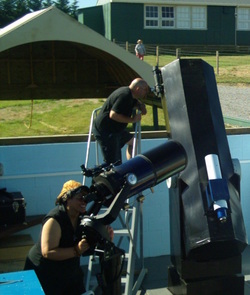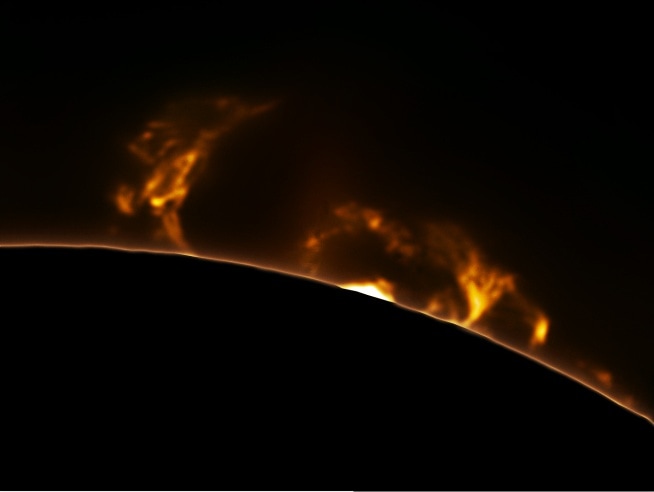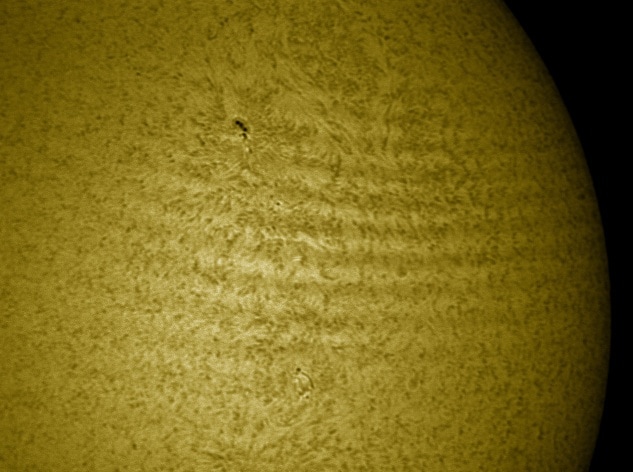 Left: 10” Mead, Right: 23” scope
Left: 10” Mead, Right: 23” scope
Phoenix Observatory
Nankivell Solar Observatory
The whole site for the Matariki Observatory has been cleared and levelled and now has an additional access road. Work on this project will continue when the Phoenix and Solar Observatories are fully functional.
- The observatory roof and roller system have been repaired.
- The mirrors for the 23” telescope are currently being re-aluminised which, when completed, will bring our largest telescope back into first-class working order. The 23” should be back on line by March. This work is being carried out and financed by Ian Cooper.
- The ‘Go-to’ telescope is in working order.
- The 10” Mead telescope has been returned to the observatory. It is currently on a portable mount and is to be mounted on one of the piers.
- A 4.5” refractor on a portable mount has also been placed in the observatory. This will replace for the time being the Peter Read refractor that was returned to Carter Observatory. We have however, a 6” Nankivell refractor currently in the store that will be mounted in the observatory at a later date. (The 10” Mead and 4.5” refractor have been supplied by Richard Hall.)
Nankivell Solar Observatory
- This observatory, which can now be used for astrophotography, will house our solar telescope. The roof and walls have been fully repaired and are now watertight.
- Cables have been laid to the observatory to operate an automated solar telescope. The live images will be transmitted to a large screen in our lecture theatre. A separate fund and fund-raising have been set up to purchase the solar telescope. We currently have about 90% of the funding required.
The whole site for the Matariki Observatory has been cleared and levelled and now has an additional access road. Work on this project will continue when the Phoenix and Solar Observatories are fully functional.
 Radio Dish
Radio Dish
Radio Astronomy
Another innovation to our observatory complex is radio astronomy. Data, sound and images will be transmitted to the lecture theatre. Observing programmes will include solar and Jovian radio activity, meteors and pulsars.
Another innovation to our observatory complex is radio astronomy. Data, sound and images will be transmitted to the lecture theatre. Observing programmes will include solar and Jovian radio activity, meteors and pulsars.
Solar telescope for TPAS
Lunt LS60THa telescope has arrived on site. It has a 60mm clear aperture, a focal length of 500mm and a bandwidth of <0.75 Angstrom.
The ‘tuning’ system on the Lunt LS60THa is different from the LS35THa and is unique to Lunt telescopes. It works by changing the air pressure within the telescope itself. This allows the Etalon surfaces to always remain at the same perfect angle to the light waves but changes the diffractive index of the air in the chamber and thus accomplishes the same result as the tilting system found on traditional solar telescopes. The system has to be set for your altitude. 94m above mean sea level at Stonehenge Aotearoa.
Also arrived on site is the DMK 41AU02.AS imaging camera. This is a monochrome camera which will be used in conjunction with the solar telescope.
There are various cables and connections that need to be purchased but the society has $400 in the savings account that can be used for these purposes.
All that remains is to set up the equipment and get viewing. Congratulations to you all for helping to achieve this goal.
Lunt LS60THa telescope has arrived on site. It has a 60mm clear aperture, a focal length of 500mm and a bandwidth of <0.75 Angstrom.
The ‘tuning’ system on the Lunt LS60THa is different from the LS35THa and is unique to Lunt telescopes. It works by changing the air pressure within the telescope itself. This allows the Etalon surfaces to always remain at the same perfect angle to the light waves but changes the diffractive index of the air in the chamber and thus accomplishes the same result as the tilting system found on traditional solar telescopes. The system has to be set for your altitude. 94m above mean sea level at Stonehenge Aotearoa.
Also arrived on site is the DMK 41AU02.AS imaging camera. This is a monochrome camera which will be used in conjunction with the solar telescope.
There are various cables and connections that need to be purchased but the society has $400 in the savings account that can be used for these purposes.
All that remains is to set up the equipment and get viewing. Congratulations to you all for helping to achieve this goal.
Page Modified 20/04/2021


